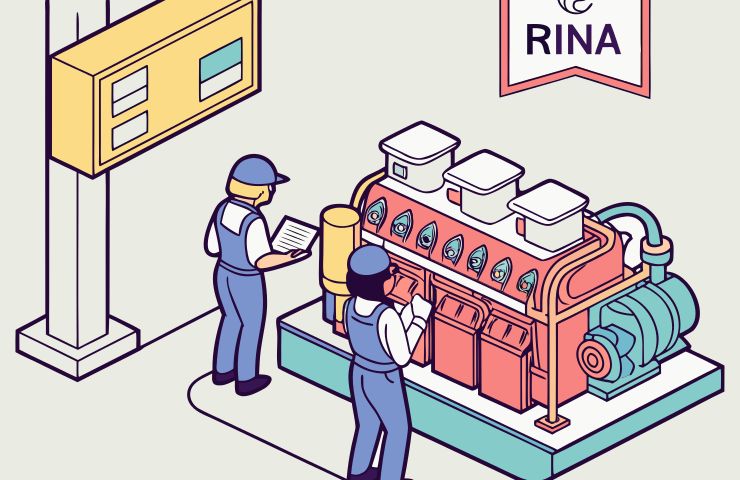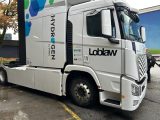
Zero-emission technology for marine engines: Newlight Marine’s Hydrogen-Diesel Retrofit Passes RINA FAT
November 10, 2025In an industry where every drop of fuel matters and rules are tightening by the minute, California-based Newlight Marine Technologies, Inc. just hit a major milestone. On 25 October 2025, their plug-and-play Hybrid Diesel-Hydrogen Injection System sailed through Factory Acceptance Testing (FAT) under the watchful eye of marine-cert heavyweight RINA.
Stringent Testing, Global Credibility
RINA’s FAT protocol, run at its engine lab in Italy, is notoriously no-nonsense. Since 1861, they’ve spread across more than 500 offices worldwide, handling everything from classification to risk assessment. Here, they crank engines through punishing scenarios—sweltering heat, bone-chilling cold, relentless vibrations, and merciless load swings—to make sure your kit won’t throw in the towel mid-ocean.
At their Genoa facility, you’ll find 5 MW dynamometers that could eat a cruise ship’s power needs for breakfast, plus environmental chambers mimicking Caribbean afternoons or Arctic blizzards on demand. Their real-time data capture snags pressure spikes, vibration quirks, and more to prove Newlight’s module keeps its cool (literally and figuratively) when cargo ops hit the turbo button.
FAT also dives deep into the backend: material trace logs, welding paperwork, QC diaries—you name it. Clearing this means shipowners can retrofit without an extra dry dock stop, slicing uncertainty and ticking off both EU directives and IMO targets in one fell swoop.
Italy’s Maritime Legacy
Italy isn’t just pizza and gelato—it boasts over 7,600 km of rugged coastline and shipyards that blend centuries-old maritime lore with cutting-edge engineering. From Venice’s historic docks to the state-of-the-art yards in Genoa and Trieste, local regs demand top-tier environmental chops—a perfect proving ground for Newlight’s retrofit.
With RINA at the helm, FAT in Italy isn’t just a checkbox—it’s a global green light, ensuring retrofit kits get instant acceptance across key shipping markets.
Deep Dive: The Injection Technology
Here’s the skinny on how it works: Newlight slices into the marine engine’s fuel rail and tucks hydrogen alongside diesel. The main players:
- A precision hydrogen injection module with ±2 bar pressure control
- An engine control interface that juggles dual-fuel timing over CAN bus or Modbus
- Marine-grade alloys and PTFE-based seals that laugh in the face of corrosion and hydrogen embrittlement
The brain of the operation is a redundant PLC network meeting SIL 2 safety standards, so a single sensor tantrum won’t sink the ship. Fast-acting solenoid valves and mass flow controllers—built tough for constant marine jostle—keep the H₂-diesel mix spot on, even when the sea gets rough.
Performance Gains Backed by Data
Numbers don’t lie. RINA’s FAT review showed:
- Up to 30% drop in specific fuel oil consumption
- Up to 60% slash in CO₂ emissions
Early sea trials, run with cargo-ready load profiles, also hint at lower NOₓ thanks to hydrogen’s lightning-fast flame speed. Stay tuned—full trial results will land once they go commercial.
Seamless Integration for Maximum Uptime
Unlike LNG conversions that bench vessels for weeks, Newlight’s retrofit installs in a typical 3–5 day maintenance window. Its compact footprint usually slips into existing engine rooms without a full-scale rehash. Shipyards get 3D CAD models in advance to dodge space conflicts and fast-track classification sign-offs.
Need updates on the fly? Handy software tweaks open the door to over-the-air patches and remote analytics, so operators can eyeball fuel burn and emissions in real time—no extra crew needed.
Compliance and Cost Advantages
With IMO’s 2030 and 2050 emission targets breathing down every shipowner’s neck, carbon levies and port surcharges are the new normal. Newlight’s retrofit helps vessels:
- Slash operating costs through fuel savings
- Unlock green financing and sustainability-linked loans
- Boost Carbon Intensity Indicator (CII) scores under EU MRV rules
Insurers are even eyeing premium discounts for retrofitted ships, potentially trimming hull and machinery cover fees.
Retrofitting: A Pivotal Step in Industrial Decarbonization
Global fleet turnover tiptoes around 2% a year. Banking on shiny new zero-emission technology builds alone won’t cut it fast enough. Retrofitting existing engines offers the express lane to slash greenhouse gases while we ramp up pure hydrogen infrastructure.
Alternative fuels—methanol, ammonia, LNG—each demand cryogenic tanks, toxicity safeguards, or complex bunkering. A hydrogen-diesel blend sidesteps those hurdles by slotting into today’s fuel networks with minimal fuss.
Meet the Startup
Founded in 2023 in California, Newlight Marine Technologies is led by co-founders Shaul Levi (CEO) and Haran Cohen Hillel. They’ve cut their teeth on everything from aerospace H₂ storage to analytics platforms for power generation, turbocharging rapid prototyping and marine-grade design.
Plugged into the F6S network, Newlight closed a seed round last year and is now in talks with major shipowners and engine OEMs for pilot installs slated in early 2026.
Their modular manufacturing line in California churns out retrofit kits in batches, driving costs down through scale. Next up? A second facility near a major port to fast-track global shipments and fuel the rising demand for sustainable energy solutions.
Collateral Impacts Beyond the Engine Room
If retrofits like this catch fire, we could see:
- New investments in hydrogen infrastructure—from port bunkering stations to production hubs
- Emerging marketplaces for engine performance analytics and real-time emissions tracking
- A public perception boost for shipping’s environmental stewardship
Software partners are already lining up to integrate Newlight’s API into wider fleet management suites, giving brokers and charterers instant access to green metrics on the go.
Operational Hurdles to Overcome
Even with the tech primed, you still need trained crews, standardized bunkering protocols, and clear local regs—many ports are still drafting their H₂ playbooks. Early adopters will have to navigate a patchwork of approvals.
Maintenance teams need updated manuals and spares kits—hydrogen-grade O-rings, gaskets, pressure sensors, the lot. Maritime training schools must weave H₂ safety modules into their courses to prep the next wave of engineers.
Market Outlook and Next Steps
Newlight’s commercial rollout is slated for early 2026, with Q1 sea trials set to deliver the transparent performance metrics shipping companies demand. Industry analysts reckon retrofit solutions could grab double-digit shares of maritime decarbonization spending through 2030.
And it’s not just RINA—other classification societies are lining up their own FAT processes for hydrogen blends, signaling a wide-open market.
Conclusion: A New Wave of Maritime Retrofit
When you think zero-emission technology, you might picture sleek newbuilds or futuristic fuel cells. But sometimes the fastest route to cleaner seas is bolting a smart retrofit onto a tried-and-true engine. With FAT approval from RINA in the bag, Newlight Marine Technologies is charting a pragmatic path to industrial decarbonization—one vessel at a time.
As regulations evolve and green hydrogen supply chains strengthen, retrofits like this could become the blueprint for other heavy industries reliant on legacy assets—from power generation to land transport—fueling the next chapter of our global push for sustainable energy.


 With over 15 years of reporting hydrogen news, we are your premier source for the latest updates and insights in hydrogen and renewable energy.
With over 15 years of reporting hydrogen news, we are your premier source for the latest updates and insights in hydrogen and renewable energy.